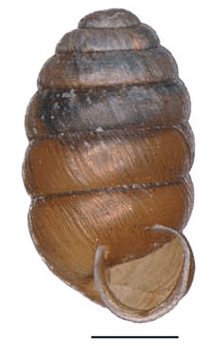Pupilla alpicola
Pupilla alpicola is a species of minute air-breathing land snail, a terrestrial pulmonate gastropod mollusk or micromollusk in the family Pupillidae.
| Pupilla alpicola | |
|---|---|
 | |
| shell of Pupilla alpicola | |
| Scientific classification | |
| Kingdom: | |
| Phylum: | |
| Class: | |
| (unranked): | clade Heterobranchia clade Euthyneura clade Panpulmonata clade Eupulmonata clade Stylommatophora informal group Orthurethra |
| Superfamily: | |
| Family: | |
| Genus: | |
| Species: | P. alpicola |
| Binomial name | |
| Pupilla alpicola (Charpentier, 1837)[2] | |
| Synonyms | |
|
Pupa (Sphyradium) alpicola Charpentier, 1837 | |
Description
The shell of this species slightly larger than that of Pupilla muscorum, with slightly more prominent growth lines, around 6 not very convex whorls. The shell apex is flat (in contrast to Pupilla muscorum and Pupilla pratensis). The apertural lip is weak; the cervical callus is weak; there are usually no teeth in the aperture, occasionally a weak parietal tooth. Note the presence of a characteristic gutter-like depression in the external surface of the last whorl, at about 1/4 of the distance from its base. (In oblique light this is also visible in the aperture as a narrow, delicate ridge).[3]
The height of the shell is 2.8–3.3 mm. The width of the shell is 1.75–1.8 mm.[3]
Distribution
The distribution of Pupilla alpicola includes the Alps and Carpathians.[3] Pupilla alpicola has a scattered distribution; it is rare.[3] Most of its habitats are close to alpine cattle pastures, and this means these habitats are now at risk, because traditional land management is decreasing.[3]
- Critically endangered in Germany[3]
- Vulnerable in Switzerland[3]
- Potentially threatened in Austria[3][4]
- Poland - critically endangered[5][6][7]
- Slovakia
Pupilla alpicola was listed as part of fauna of the Czech Republic for a long time, (as "probably extinct" in Bohemia and critically endangered (CR) in Moravia).[8] After a very similar taxon Pupilla pratensis was elevated to its species level in 2009,[4] the revision showed that Pupilla alpicola does not live in the Czech Republic and all of the supposed records from that country are actually Pupilla pratensis.[9]
Ecology
Pupilla alpicola occurs in moss, within wet meadows in high alpine regions, mostly in calcareous fens.[3] In Switzerland it lives between 900 and 2500 m altitude.[3]
References
This article incorporates public domain text from the reference.[3]
- von Proschwitz T. & Rüetschi J. (2013). "Pupilla alpicola". The IUCN Red List of Threatened Species. Version 2014.2. <www.iucnredlist.org>. Downloaded on 30 July 2014.
- Charpentier J. de (1837). "Catalogue des mollusques terrestres et fluviatiles de la Suisse. Formant la seconde partie de la faune Helvétique". Neue Denkschriften der Allgemeinen Schweizerischen Gesellschaft für die Gesammten Naturwissenschaften - Nouveaux Mémoires de la Société Helvétique des Sciences Naturelles 1(2): 1-28, Tab. I-II [= 1-2]. Neuchatel. page 16.
- "Species summary for Pupilla alpicola". AnimalBase. Last modified 30-01-2010, accessed 30 July 2010.
- von Proschwitz T., Schander C. , Jueg U. & Thorkildsen S. (2009). "Morphology, ecology and DNA-barcoding distinguish Pupilla pratensis (Clessin, 1871) from Pupilla muscorum (Linnaeus, 1758) (Pulmonata: Pupillidae)". Journal of Molluscan Studies 75(4): 315-322. doi:10.1093/mollus/eyp038.
- Beata M. Pokryszko. "Pupilla alpicola (Charpentier, 1837)". Instytut Ochrony Przyrody Polskiej Akademii Nauk.. accessed 30 July 2010.
- (in Polish) Alexandrowicz S. W. (1992). "Nowy dla fauny polskiej gatunek ślimaka Pupilla alpicola na zagrożonym stanowisku w Niedzicy". Chrońmy przyr. ojcz. 48: 5-11.
- Alexandrowicz S. W. (1994). "Pupilla alpicola (Charpentier, 1837) from Niedzica". Geologia 20: 325-331.
- "Red List of the molluscs (Mollusca) of the Czech Republic". accessed 30 July 2010.
- (in Czech) Škodová J. & Horsák M. (2010). "Zrnovka slatinná (Pupilla pratensis (Clessin, 1871), Gastropoda) - staronový druh našich mokřadů. In: Bryja J. & Zasadil P. (eds.) Zoologické dny Praha 2010. Sborník abstraktů z konference 11.-12. února 2010. Archived 2018-04-10 at the Wayback Machine Ústav biologie obratlovců AV ČR, Brno, ISBN 978-80-87189-07-8. Pages 214-215.
External links

